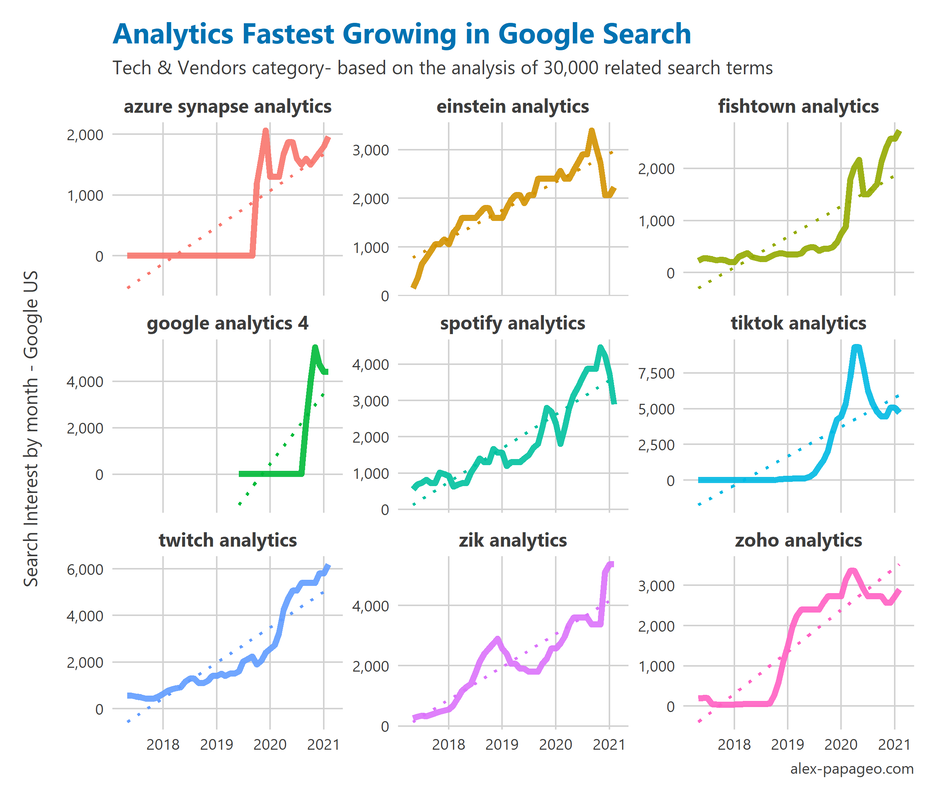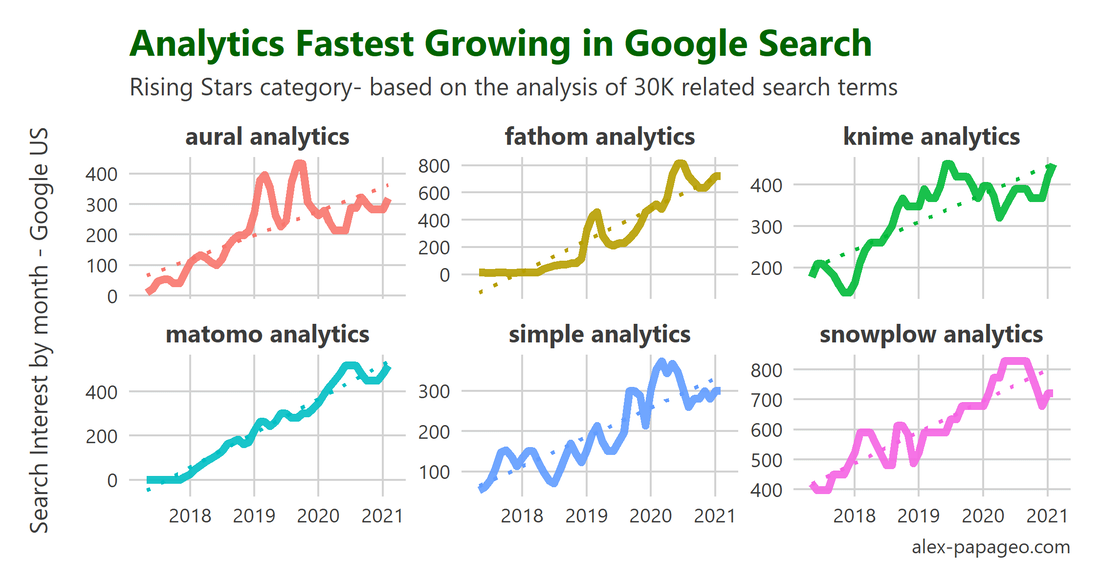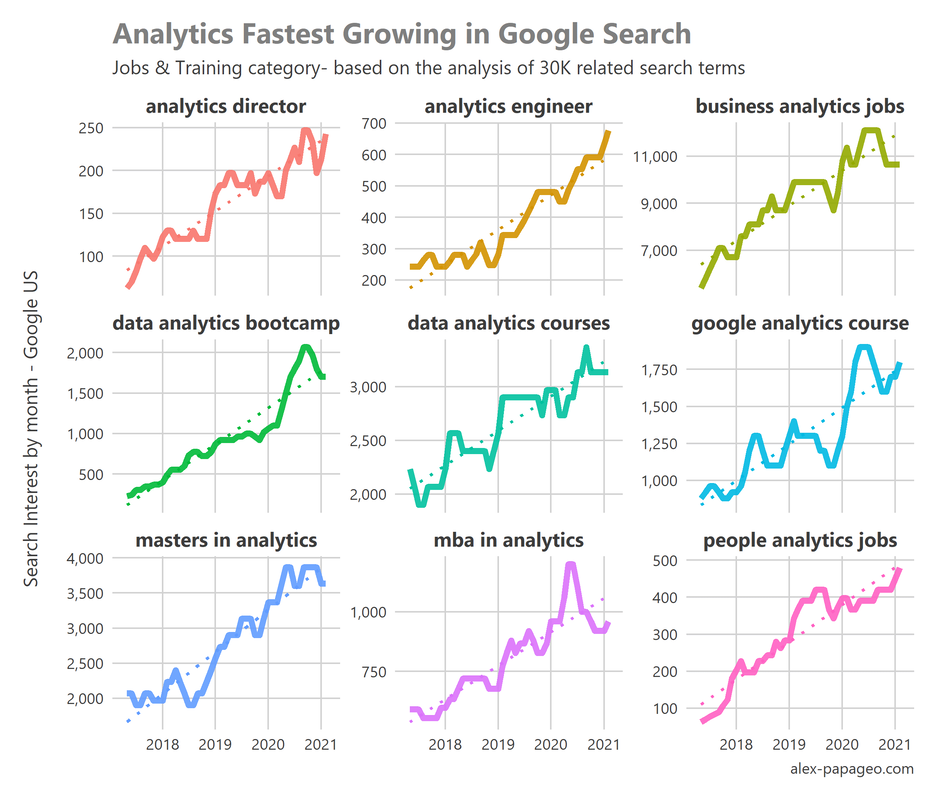|
The benefits of search data go beyond SEO-focused keyword research. It is a valuable resource for both market and product research, too. In fact, it can even be integrated into all research types and intelligence analyses where listening to and decoding the consumer’s voice plays an important role. I’ll explain how this is possible through an example focused on the analytics industry. I will also discuss 6 reasons why search data can be used as a key source of insight at the strategy level. Some Background This research was inspired by Krista Seiden’s 2020 talk at Xoogler.co on key trends in the analytics industry with a particular focus on the various technology stacks. Krista didn’t use search data, instead her talk was based on data she had collected by conducting her own research. She surveyed a large sample of individuals who work in the analytics industry. Understanding these trends is part of my work as a consultant, so I have a natural interest in them. Given my work in the analytics industry and my interest in exploring what’s next in this space, I felt inclined to contribute to this line of work by following a similarly data-driven approach. Why Search Data It would have been practically impossible for me to reach the number of analytics professionals Krista had in her study, so I decided instead to use publicly available search data and see if any noteworthy trends would emerge. At that point in time I was actually already thinking about the potential benefit of this type of analysis — but for a different reason. Covid-19 was at its peak, and it was becoming obvious that the pandemic was strongly impacting consumer behaviour. Finding ways to look closer at how consumers search for products online and which new search patterns are emerging could offer useful insights. Moreover with increasing barriers in the tracking of user behaviour, any additional data sources that echo the consumer's voice, become highly useful. I hypothesised that search data could also provide another complementary angle to the original analytics trends research. So, I set out to collect search query lists and analyse keyword search volumes. The Analytics Trends Research Method I created and data-mined a keyword universe for Analytics, looking for the fastest-growing trends. The method deployed was as follows.
3 Trends in the Analytics Industry Based on Search Data A number of noteworthy findings naturally emerged from this analysis, which gives a good indication of the insights that search analysis can produce. I will briefly discuss three of them below. If you are interested in exploring the trends yourself, check out the web app https://analyticstrends.app 1. Fastest-rising analytics tech and vendors These are the fastest-growing analytics tools, technology and vendors in mainstream analytics tech. Some of the tools, like Einstein and Spotify analytics, have grown in very consistent ways over the course of the last four years. Others, like Google Analytics 4, follow a hockey stick curve. It’s often worth looking at the causes of the specific search behaviour for the various topics — in Google Analytics 4, for example, the surge in search interest was the result of a new product announcement. On the other hand, Fishtown Analytics (another term with close-to-meteoric rise) released a popular open-source tool that contributed to its rapid growth. 2. Rising stars in analytics It’s easy to keep the focus only on the terms and topics that have the largest volumes of traffic. However, valuable insights can be found anywhere within the keyword universe. A number of analytics software vendors — in some cases, we could think of them as niche players — have grown very consistently, even though some literally started from zero. An interesting insight is that three out of the six vendors in the graph belong to the category of ‘privacy-first’ analytics, which seems to be a reaction to all the privacy legislation and discussions that followed over the course of the last few years. It is a strong signal that the new privacy landscape can create significant opportunities for new players in the analytics space. Matomo, Fathom and Simple Analytics have exhibited fast and consistent growth while being vocal about privacy protection and their commitments to it. 3. Fastest-growing terms in Analytics jobs and training This last trend illustrates the increasing demand for analytics-related roles, such as analytics engineers and analytics directors. Demand for specialised roles is followed by strong demand for training and courses that qualify professionals to work in these roles. The high demand for analytics jobs and education is not a surprise in itself, but the pace of growth is quite impressive — look at the rise of search interest for analytics engineers and analytics bootcamps. Search Data: Going from Tactical to Strategic I’ve used search and keyword data for a long time, mainly working with it from a tactical standpoint for keyword bidding, ROAS calculations, keyword rank tracking and keyword research for SEO purposes. While working on this analysis, it became obvious to me that search data can play a strategic role when making business decisions involving products, markets and consumers. The analysis above only scratches the surface, there is so much more to be explored when the terms within a ‘keyword universe’ start to be grouped or clustered based on their semantic, lexicographical or other case-specific attributes. I have prioritised the use and analysis of search data in my work since the analytics trends study. Below, you’ll find several ideas on how to use search data strategically in your organisation. 6 Ways to Use Search Data Strategically in Your Organisation 1. Use it to observe the bigger picture of what’s changing in an industry. The example in this article comes from the analytics industry, but it could be any other industry or market. Search data analytics can be useful in identifying rising or declining search interest in products, markets or topics, while also helping businesses understand the specific patterns in which the change unrolls. Some terms, for example, can have a meteoric rise and fall compared to others that grow slowly but surely over time. Understanding these patterns is essential when deciding whether to invest in a new product or market for the long term or take advantage of short-term opportunities, i.e. marketing campaigns that focus temporarily on topics that spike in search interest for just a short time. 2. Analyse search data to identify emerging business opportunities. For example, detecting high demand from specific locations could be a good reason to examine the potential to enter a new market. If you are already considering expanding, it can help you mitigate risk once you know there is a guaranteed level of demand. Search data can also be valuable when calculating the potential size of a market of interest in terms of search demand and provide estimates about the level of competition and search market share. By examining and combining these trends, you can capture high-potential business opportunities before your competitors, come up with new product ideas or identify opportunities early on, positioning your organisation for a first-mover advantage. 3. Search data analytics can focus on existing markets and products too. It can enable companies to understand the language that consumers are using to look for or describe their specific products and services. This is particularly beneficial for startups because it requires significantly less investment than other primary market research forms, for example, involving focus groups, surveys of population samples, etc. Moreover, it can be performed and delivered in a much shorter time frame. ‘If you’re trying to persuade people to do something or buy something, it seems to me you should use their language, the language they use every day, the language in which they think.’— David Ogilvy 4.Understand demand composition and anticipate future demand. This could be particularly useful for e-commerce businesses. Understanding the seasonality for certain products and generally the level of demand and where it comes from can help in many ways: from better planning of logistics and managing the stock to better controlling the timing and intensity of marketing campaigns as well as prioritising product promotions within those campaigns. The remaining two in this list of six illustrate the importance of search data in 2021 and beyond. 5. Understand Covid-19 impact on consumer behaviour. The pandemic has dramatically impacted our lives, and this has no doubt changed the ways we research and purchase products and services. Many of these changes are expected to continue. Detecting these changes as they happen and getting a deeper understanding of what’s behind these new trends is another use case of search data analysis. In fact, in many cases, these changes inspire businesses and entrepreneurs to create new products and services or find new ways to deliver existing ones to the consumers. 6. Counterbalance the impact of privacy-related restrictions on the tracking of consumer journeys. Privacy legislation and browser restrictions make it increasingly hard to track consumer behaviour. This gives the incentive to make the most of aggregated and anonymised data, such as search data, to reach insights about what’s top of mind for the consumer in the various stages of the customer journey. This is key information to understand about consumers and help your business make informed choices based on it — even before the consumers land on your website the first time. Closing Thoughts We’ve looked at how the analysis of search data can become a source of strategic insights for an organisation. In simple words, it is a straightforward way for businesses to feel the pulse of the consumer as it happens. The analysis is applicable on the industry, market or product level, and the results support decision making at many levels within an organisation, including, most importantly, the strategy level. Working with search data is very accessible to companies regardless of size since it doesn’t require large budget commitments compared to other forms of market and product research. The data are aggregated and anonymised, and several sources are available either from Google (Google Trends or Google Ads platform) or from other providers, e.g., SEO platforms that make data of this type accessible. Finally, now might be the right time to start analysing search data more systematically to better understand all the recent radical shifts in consumer behaviour and regain an understanding of the consumers and their journeys regardless of current or upcoming privacy regulations. Have you encountered other interesting use cases of search data analysis? Let me know in the comments below. Alex Papageorgiou
0 Comments
Your comment will be posted after it is approved.
Leave a Reply. |
|






